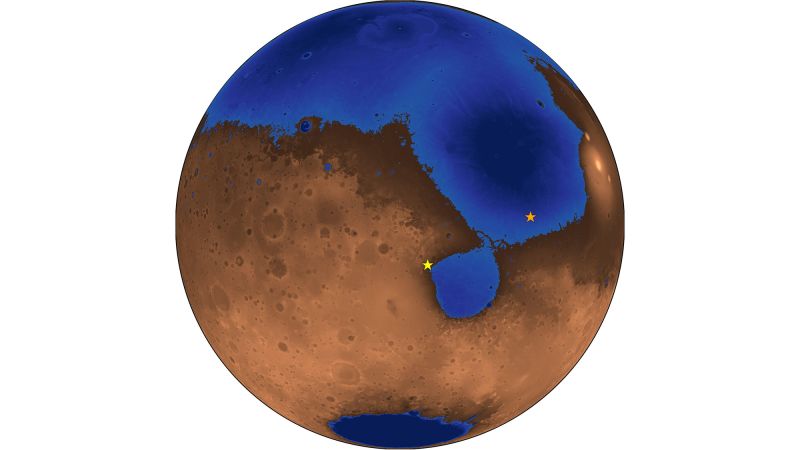Recent groundbreaking research suggests that Mars may have once harbored a vast ocean teeming with life-sustaining possibilities, a discovery drawn from data collected by China’s Zhurong rover. According to findings published in the esteemed journal “Proceedings of the National Academy of Sciences,” the rover, which operated from May 2021 to May 2022, detected features resembling ancient shorelines on the planet’s surface, dating back approximately 3.6 billion years. This pivotal evidence may reshape our understanding of Mars as a once-warm and wet environment, potentially suitable for life.
Zhurong landed in Utopia Planitia, an expansive plain situated within Mars’ largest known impact basin. The location of the rover is significant as it lies near several ridges, long speculated by scientists to represent remnants of an ancient shoreline. Researchers were keen to investigate these landforms for telltale signs of water, which has been a focal point in astrobiological studies of Mars. The planning and execution of the mission exemplify a new era of Martian exploration, combining advanced technology with astrobiological theory.
The findings draw on comprehensive data gleaned from the rover’s sophisticated ground-penetrating radar system, allowing scientists to peer beneath the Martian surface and reveal hidden rock layers. Benjamin Cardenas, a co-author of the study and assistant professor at Penn State’s Department of Geosciences, stated, “We’re finding places on Mars that used to look like ancient beaches and river deltas.” This invites further intrigue into the Martian climate, suggesting it was potentially warmer and wetter for millions of years longer than previously believed, offering tantalizing prospects for life.
In earlier decades, NASA’s missions, particularly Mariner 9 and Viking 2, were the first to suggest the existence of ancient oceans on Mars. Utopia Planitia dates back to the Hesperian Period, an era around 3.7 billion to 3 billion years ago, when Earth may have already hosted life. Nevertheless, the region presented scientists with a unique puzzle, as it lacked abundant evidence for standing water, contrasting with the ancient regions of Mars that showed greater signs of past aquatic environments.
Aaron Cavosie, a planetary scientist from Curtin University, highlighted the significance of this new data, remarking that features such as canyons observed by Mariner 9 were primarily interpreted as indicators of dramatic groundwater eruptions rather than standing water bodies. The current findings might shift this paradigm, potentially suggesting a more complex and varied history of water presence and climate dynamics on Mars.
Zhurong’s radar data revealed sedimentary structures buried up to 260 feet under the surface. The rover detected sediment formations akin to Earth’s beaches, indicating activity from wind and waves—a hallmark of a vibrant coastal environment. The alignment of these geological features suggests they were part of an ancient shoreline, presenting key insights into how the Martian landscape evolved over billions of years.
Moreover, Zhurong’s findings illustrate the geological impact of ancient rivers, likely responsible for transporting sediment into the ocean and creating deltaic environments. These changes occurred over immense time frames, and Cardenas pointed out that such dynamic interactions between land and ocean might offer clues to ancient habitable conditions on Mars.
Yet, even as excitement grows within the scientific community, skepticism remains. François Forget, a senior research scientist at the French National Centre for Scientific Research, warned against jumping to conclusions solely based on the radar data, emphasizing the alternative explanation of aeolian (wind-driven) processes leading to dune formations.
Conversely, the results garnered encouragement from other planetary scientists, such as Dr. Joe McNeil, who recognized the depth of evidence supporting the possibility of an ancient ocean. He noted that if the coastal deposits indeed represent sedimentation along an ancient ocean’s edge, this could imply a long-standing stable hydrosphere, substantially impacting Mars’ climatic history.
In summary, the discoveries made by the Zhurong rover contribute to a growing body of evidence suggesting that Mars might have had a hospitable oceanic environment. These findings not only shape our understanding of Mars’ past but also expand our search for extraterrestrial life, suggesting that conditions akin to Earth’s earliest habitats may have existed beyond our own planet. Further investigations will seek to clarify the extent and duration of these ancient bodies of water, as the pursuit of understanding Mars’ enigmatic history continues.












